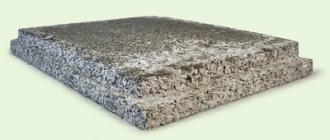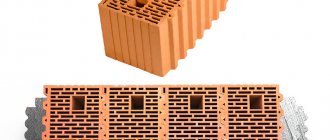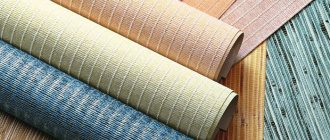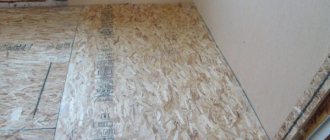All the numerous advantages of silicone sealants do not make this sealant ideal. In some cases, acrylic sealant will do the job better. Our article will tell you what the product is made from, what it comes in, and how it differs from its silicone “brother.”
Depending on what the composition becomes after use, all sealing agents are divided into three groups:
- Non-hardening compounds are sealants in the form of mastic, the most primitive of which is ordinary plasticine.
- Hardening compounds are silicone materials that harden as a result of a chemical reaction (vulcanization process).
- Drying compounds - such sealants become solid due to the gradual evaporation of the liquid.
This group includes acrylic sealants created on the basis of polymers. After application, the material only needs one day to dry. The one-component acrylic sealant is completely ready for use after opening the package. Other types of sealants are two-component formulations: their components must be pre-mixed before use.
Acrylic sealant: main characteristics and qualities
Acrylic is considered easy to use; it does not harden for a long time, thanks to which it will be possible to correct errors in the position of the seam.
The advantages of using an acrylic sealant are its ability to adapt to the environment, it is moderately elastic, and due to its properties, after drying it is recommended to plaster it and then subsequently paint it.
Acrylic sealant is suitable for various holes, sealing cracks: pour into the hole and wait until completely dry. Acrylic feels great indoors and resists deformation due to changes in temperature and moisture.
When working outdoors, acrylic does not have a very favorable composition; due to the lack of frost-resistant properties, acrylic will simply crack. Why buy acrylic-based sealants? To seal cracks, different holes.
Quite easy to use, fill a crack or hole and wait for it to dry.
It copes well with deformation due to changes in temperature and humidity, and also feels great indoors.
It is not recommended for use outdoors or in cold rooms, as subsequent defects may occur when using it due to the lack of frost-resistant additives in the composition.
To use in the cold, you need to take special frost-resistant seals, we will talk about them later in this article.
Criterias of choice
The main purpose of sealing compounds is to seal joints, cracks, seams of movable and fixed structures and surfaces. Walls, flooring, joint gaps, deformations, voids, cracks - acrylic sealant can be used for a variety of purposes. To carry out household repairs, it is enough to buy a small package of one-component sealant; for professional use, larger-capacity formulations with the inclusion of fillers (additives, modifiers) are needed.
How to choose acrylic mixture:
- Area of use - porous or smooth surface, joints of moving or fixed structures, interior or exterior work, type of material (metal, plastic, PVC, wood, concrete). You can choose a composition for specific work or a universal product.
- Operating conditions – the probability of periodic changes in temperature and humidity, ingress of precipitation and moisture, and mechanical influences (shocks, loads, vibrations) are taken into account. For wet rooms and outdoor work - sealants with fungicides, for heated surfaces - heat-resistant, fire-resistant mixtures.
- Composition and technical characteristics - there are ready-made products and substances on sale that require mixing. You need to study the manufacturer's instructions - temperature of application and operation, width and thickness of the seam, setting and complete drying time, consistency and properties, method of application.
- Decorative component - classic transparent and acrylate white sealant can be used for any type of insulation. But if you need a colored composition for a complete design, you can choose a product of the desired shade or paint the basic white sealant after drying.
It is worth paying attention to the brand and reviews about the quality of the manufacturer’s products. If large-scale work is planned, you need to buy mixtures with a reserve. If there are deformations or uneven differences on the surface, the composition consumption per square (or linear) meter will be greater than the average value specified by the manufacturer.
Tip: Before purchasing sealant, you need to read the expiration date on the packaging and check the integrity of the container. Most manufacturers indicate a shelf life of 12 months for products in sealed original packaging.
On video: Acrylic sealant for sealing joints, corners and cracks.
Technical aspects of acrylic sealants
Quality marks of acrylic products: with maximum pressure on the sealant, maximum elongation of the substance occurs.
If the sealant is stretched too tightly and there are side effects on it, the material will begin to deform. How to determine the elasticity of a seal? Very simply, the value will be written as a percentage.
The standard sealant has 10%, this figure is enough for a high-quality sealant. If 11-13% elasticity is specified, with these indicators, it will be perfect for outdoor work. Other characteristics characteristic of high-quality sealants:
- Possible seam width - from 6 to 50 mm;
- the ideal thickness of the seams is 1⁄2 of its width;
- temperature of use - from -20 to +75 degrees;
- a film forms on the surface of the seam after - 15 minutes;
- the sealant sets to the surface within 1 hour;
- the duration during which it will dry is one day at a humidity of 50%, temperature +25 degrees;
- vulnerability to frost - from - 5 degrees;
- the approximate gap value is 550%.
Acrylic sealants are packaged in different containers: buckets, tubes of different sizes, tubes, etc. The sealant has a shelf life of 1 year when unopened. Storage temperature is from 15 to 25 degrees.
The composition of the sealants includes:
- antifoam;
- surfactant;
- ammonia in the form of an aqueous solution;
- fillers;
- thickeners;
- antiseptics;
- ammonia in the form of an aqueous solution.
Popular brands
There are different sealants in stores, the most popular are the following compositions:
- “Universal” from Novbytkhim. An inexpensive product based on acrylate dispersion and mineral filler. After drying, it forms a moisture-resistant, rubber-like white seam that does not turn yellow over time. The sealant is non-toxic and can withstand temperatures of –30…+70 degrees. Designed for repair work indoors and outdoors.
- Zigger Acryl. Plastic, elastic means for compacting various substrates. Includes a freezing point depressant additive. It is thixotropic and can be applied to vertical bases and ceilings.
- "Moment Acrylic Universal". It is used for strengthening and sealing cracks and crevices in windows, for sealing joints between plumbing fixtures and floors and walls. Can be applied to the junctions of metal sinks and walls, countertops in the kitchen. Retains properties at temperatures of –50...+150 degrees, is neutral with respect to alkalis, oils, and remains durable for several years.
- Belinka Beldom Acryl. Acrylate sealant that is suitable for all building materials. Sufficiently elastic, withstands deformation within 5–10%. Does not wear out, is resistant to sunlight and weathering.
- Loctite PL-S50. Universal frost-resistant composition based on acrylic water dispersion. Designed to strengthen weak joints between concrete, brick, wood, plaster, and ceramics. Ideal for grouting cracked surfaces. Suitable for painting and plastering.
- Makroflex FA. Freeze and thaw resistant sealant. Suitable for external and internal work. The seam can be painted an hour after drying. Can be used for all types of seams with slight deformation and stretching.
- PENOSIL Premium Acrylic Sealant. A universal water-based acrylic composition used for filling joints and cracks in low-moving joints. It is odorless, easy to apply, and after drying it can be sanded and coated with paint or varnish. It is quite moisture resistant and can easily withstand contact with water 5 hours after use.
There are other acrylic-based sealants in construction stores: Titan, Krass, Master Tex, Pufas, Kim Tek and others. There is no need to save money and buy the cheapest composition. Products from well-known brands are of consistently high quality and highly effective. Working with acrylic sealants is easy and convenient; they will become reliable helpers in the home and on construction sites.
Where is the sealant used?
Due to the fact that the product does not contain toxic substances or chemical solvents, it can be used in a residential building.
The product is safe for humans, so its use can be carried out without special protection or means of ventilating the room.
Acrylics are used to fill seams, joints and cracks connecting small elements to walls. Suitable for working with surfaces of wooden, concrete, reinforced concrete objects.
Acrylic is also used for gluing skirting boards, as well as gluing tiles (also thanks to this, the gaps will be covered immediately). The product will help in gluing fillets and baguettes.
Comparison table of characteristics
In order to compare the presented options, we suggest considering a short table with the main characteristics.
| Model | Volume (ml) | Tone | A country | View |
| RAVAK PROFESSIONAL X01200 | 310 | white, transparent | Czech | silicone |
| KIM TEC SILICON ACETAT 101E | 310 | white, transparent | Germany | silicone |
| BELINKA BELSIL SANITARY ACETATE | 280 | white, transparent | Slovenia | silicone |
| MAKROFLEX SX101 | 85 | white | Estonia | silicones. |
| MOMENT GERMENT | 280 | transparent, white | Germany | acrylic. |
| CERESIT CS 7 | 280 | white | Türkiye | acrylic. |
| MASTERTEKS PM UNIVERSAL | 290 | white | Poland | silicones. |
What is the difference between acrylic sealant and silicone
There is a difference between silicone and acrylic-based compounds both in properties and in application features:
The difference between these two sealants is in the properties and application specifics:
- The first difference between them is that acrylic is processed. Suitable for any type of paint and holds it well. Acrylic sealant can be repaired, so you can update problem areas without unnecessary actions. What can you say about silicone sealant? It’s impossible to paint it, and even if you do, it won’t last long and will peel off.
- Silicone sealant cannot be processed by mechanical processing; if used, it will destroy and damage the joint. But acrylic lends itself well to mechanical processing. By machining we mean: grinding and drilling.
- Acrylic sealants tolerate moisture much worse than silicone ones. Acrylic sealants contain an aqueous dispersion of acrylates, which is why it will be prone to dissolution. But silicone sealant contains waterproof substances. Like rubber.
- In terms of elasticity, it is superior to silicone sealant. The sealant has greater ductility, shrinkage is less common, stretches much better and without damage.
- Acrylic has good adhesion to building materials, and also interacts well with concrete and wood. Before you start working with the product, it is worth treating the surface. Make it smooth for a more visible effect.
- Acrylic sealants have a much wider range of colors. This aspect will help you choose the right color or even shade for a visual effect, even for different types of wood. At that moment. When silicone sealants have a rather poor range of colors, only 4 colors (red, white, black, grey)
- If we consider the question of which seal will last longer, then it is silicone (can last up to 20 years). When acrylic will deteriorate earlier, as it has the property of drying out.
- One of the most important points for most buyers is price. The cheapest product based on the criterion is considered to be an acrylic sealant. Approximately the difference in all stores will be 30-50%.
- Acrylic sealant is environmentally friendly. These sealants are absolutely harmless to people and the environment. Silicone-based sealants emit a specific odor due to acidic elements, so they are not recommended indoors
Acrylic sealants are excellent for indoor use, but for the seal to function for a long time, it should not come into contact with water or high humidity.
If you care about aesthetics in your space, then acrylic caulk is the perfect choice for you, with its color range and combination with paint. It is most often used in window frames, covering cracks there, sealing doorways, etc.
Silicone seals are used for use with plumbing fixtures, aquariums, and are perfect for work where there is constant contact with water, when working outside the interior space.
When working with surfaces: metal, stone, concrete, it is worth using acrylic products, since silicone contains acids.
What it is
A distinctive feature of the mixtures is the water content. The moisture evaporates, forming a durable sealed layer. The basis of the products is polymethylacrylate, which belongs to the category of plastics. The formed seam has good elasticity, uniform filling and resistance to stress. Acrylic sealants come in classic white, transparent and colored. The formula of sealants includes several substances:
- To ensure optimal viscosity, thickeners are added to the aqueous dispersion.
- Acrylic sealants are protected from moisture, temperature changes and aggressive environments by plasticizers and fillers.
- Antiseptics give the mixtures antibacterial properties. The composition also includes surfactants, defoamers and ammonia solution.
Manufacturers produce sealing products in the form of pasty and viscous-fluid substances. The scope of use of acrylic sealants is very wide. They are used for industrial and domestic purposes, during internal and external construction work. Thanks to the special properties of the materials, the frozen mass provides reliable protection against the penetration of cold and does not allow moisture and dust to pass through.
Important: Acrylic sealants have a long service life, which is 15 years or more. The compositions are universal, therefore suitable for performing a wide range of repair, installation and construction work.
Moisture-resistant sealants
These sealants may have a mixed composition (for example, silicone sealant or rubber) or the presence of other improving substances.
Perfect for use in rooms with high humidity. Thanks to moisture-resistant substances, the sealant tolerates temperature changes well and has high adhesion to building materials. These sealants adhere better to plastic, foam concrete, and ceramics.
Frost-resistant sealants
The products that belong to this group are adapted to cold temperature conditions and snowy weather.
These seals have a high level of elasticity, due to which they freeze and do not crack from the cold. A large number of these products are used down to -20 degrees, but there are also sealants that can withstand colder temperatures.
Such sealants are used for seams between logs, concrete slabs, and are used for warm seam technology.
Methods for removing traces of product use
After you have repaired a crack or seam, you need to clean the surface that received excess material. It is recommended to do this immediately after finishing work. But when the product has already dried, it will not be so easy to remove it; for this you can use a razor blade; all you need to do is clean the untidy areas with a few quick movements. Then you need to clean the surface with a brush. An ordinary stationery knife is also suitable for this work.
In more complex cases, you can use a solvent for this type of sealant. To do this, first put on a mask and be sure to use protective gloves. Half an hour after applying this product, you will need to wipe off the residue with a napkin. For the same purpose, you can remove excess sealant using white alcohol.
Difference in color
The standard colors for sealants are white and colorless; they can be found in every store that sells seals.
They are also considered the most popular because they are perfect for tiles, plumbing fixtures, sinks; colorless sealants are excellent to use, since they are almost invisible when used.
But sealants are not only rich in these two colors; if you need to disguise the sealant against the background of the overall picture, there are also colored seals (gray, yellow, green, brown and others).
There are sealants that match the color of the wood: maple, spruce, pine, cherry, etc.
Colors
Acrylic products can be classified according to the presence of pigment dyes. Classic clear sealant or acrylic white compound is considered a standard universal solution. But sometimes it becomes necessary to get seams of a certain color so as not to disrupt the design and aesthetics of the structure. In this case, you can choose an acrylic sealant of the appropriate shade:
- Basic colors – white, beige, grey, blue, green, brown, black.
- Non-standard color solutions – light and dark tones of basic colors.
- Shades that imitate wood - beech, honey, wenge, larch, golden pine, rosewood, teak, birch, cherry.
It is easy to choose a colored sealant to match the structure of a wood surface or concrete base. If the color scheme does not contain the desired color, after the product has dried, paint with water-based materials. They are colored and white, which can be tinted with pigments to obtain the desired shade.
Positive and negative features of sealants
Akriplast are excellent at repair work, construction work, and plumbing work. Positive features of acrylic sealants:
- low price;
- a large assortment
- elementary to use;
- resistance to UV radiation;
- environmental friendliness;
- possibility of error correction;
- possibility of restoration work outside the sealed area;
- fire safety, non-flammability;
- safe to use;
- good level of adhesion to many surfaces;
- painting, mechanical treatment of the seam, puttying;
- ability to work without protective equipment;
- vapor permeability, absence of condensate accumulation in joints; darkening of the seams over time, no yellowing.
The negative features of acryplast are its poor interaction with places where there is frequent contact with water.
In this environment, the product will quickly begin to break down. Only moisture-resistant seals can interact with a damp environment after the seam has completely dried.
Although even these products do not guarantee long service life, it will deteriorate over time with frequent contact with water.
Famous brands and reviews
Domestic and foreign companies produce a huge range of acrylic sealants. Each manufacturer has several product lines - one-component and two-component compositions, colored and non-pigmented sealants, mixtures with additional properties - water resistance, frost resistance, deformation strength.
10 acrylic products that occupy a high place in the ranking and are in wide demand:
- German sealant Zigger. Optimal price-quality ratio, products are manufactured in Germany. The manufacturer’s line includes a product for laminate flooring, produced in a compact tube with a volume of 310 mg. Shade options - gray and imitation natural wood. A white acrylic sealant, available in a 50 mg tube, is specially designed for cracks on walls.
2. Recognizable German brand Henkel. According to customer reviews, the products of this brand have impeccable characteristics. The compositions have good frost resistance, which allows the use of sealants for exterior work in harsh climates. The mixtures can be used to fill the seams of low-moving structures and be used to repair floors and treat walls.
3. Loctite sealants are widely used for household needs, professional repairs, and car maintenance. PL S50 compositions firmly adhere to concrete, brick, and wooden bases. The frost-resistant mass can withstand climate changes and is suitable for processing joints of street structures. Loctite compositions come in classic white and colored.
4. Finnish Makroflex mixtures have received a large number of positive consumer reviews. Acrylic-latex products with high frost resistance are widely popular. The mixtures can be used to seal seams and joints on outdoor structures and indoors. The cost of products falls into the middle price category.
5. Petersburg produces universal acrylic white sealant in a small package - a 50 ml tube. Every buyer will be able to buy an inexpensive product. The elastic, airtight and moisture-resistant composition is not inferior in quality to imported analogues. The manufacturer produces mastics and paints and varnishes.
6. Domestic-made sealant “Accent”. The company produces one-component sealants (Accent 117), siliconized substances (124), and compositions for wood processing (128, 136, 140, 125). Accent products are classified into household and professional acrylic sealants, which can be used to cover seams of different thicknesses.
7. The Slovenian brand Belinka produces high-quality products that meet European standards. The manufacturer's line of products includes a universal composition and a separate sealant for parquet. Environmentally friendly products have optimal properties and characteristics. The universal sealant and parquet cleaner are supplied in 300 ml packages.
8.Compositions of Soudal. The mixtures are easily smoothed with a spatula and fill seams and voids well. The cartridge has a convenient dispenser spout. Acrylic sealant Soudal for sealing joints and seams fits neatly on horizontal and vertical surfaces made of different materials. After complete drying it can be painted.
9. Russian Cosmofen products are produced under the Penosil brand. The company produces acrylic products of three modifications - Cosmofen ca 1 universal, Cosmofen plus hv for sealing plastic structures, Cosmofen plus-s for processing foam and PVC. The compositions have pronounced adhesive properties and can be used as a fixing adhesive.
10.The popular sealant CERESIT CS 7 has waterproof qualities, therefore it is used when installing plumbing fixtures. Despite the acrylic base, the product provides reliable insulation of joints from moisture and does not crack upon contact with water. According to reviews, Ceresit brand products are reasonably priced and of good quality.
Viscous-flowing and paste-like sealants with a polymer acrylic base are produced by many companies in Russia and abroad. The characteristics of most products meet the requirements of buyers and are reasonably priced. Before purchasing, you need to pay attention to the area of use of the sealant (outdoor/indoor) and the type of surface to be treated.
Which sealant is better to choose?
There are special products for specific places, for example for doors, for windows. We can say they are almost no different.
When working with smooth surfaces, additional actions are required: level the surface with sandpaper or use a special primer with abrasive particles.
Most often, these methods are used for PVC, polycarbonate or other types of plastic.
When purchasing a sealant for a bathroom or kitchen, it is worth checking it for moisture resistance and also checking whether it contains fungicides.
To use a sealant in high temperature conditions, it is worth purchasing silicone sealant or sealant, they have excellent heat resistance.
If you need a sealant for use in an aquarium, you should not take an acrylic one; it will begin to deteriorate quickly; you should use a silicone sealant.
Of course, if we talk about using a seal in the bathroom, and directly in the shower, then you should take a silicone seal.
But for working with windows, acrylic is suitable, and after it has completely dried, it can be painted in the color you need.
Consumption
To calculate the exact amount of sealant required for the job, you need to know the dimensions of the joint that needs to be filled. The depth of the seam is multiplied by the width of the future strip and the flow rate is obtained. Consumption is taken per meter and expressed in grams. If the seam is planned to be triangular in shape, then the flow rate can be divided by two. This case is suitable for processing the connection of perpendicular surfaces.
To seal a crack, it is necessary to take extra sealant , since it is almost impossible to find out the exact dimensions of the crack. To process a seam 10 meters long, you need to spend 250 grams of silicone. The sealant is produced in tubes of 300 grams - this amount is enough to treat a given surface. It is better to purchase colored sealant from one brand and one batch, since the shade of the product may vary.
Using sealant does not require additional equipment or special skills. The material does not have a strong odor and does not irritate the skin. The work can be performed without special respiratory and skin protection. The composition can be easily washed off with warm water from hands or tools.
Uncured composition is easy to remove.
When treating surfaces with sealant, certain rules should be followed. Do not change the humidity and temperature in the room until the composition has completely dried. In the bathroom
You cannot use water in the kitchen if the surface of the sealant has not hardened. Otherwise, the risk of the adhesive composition eroding is high.
The curing process of the sealant is conventionally divided into two stages. First, the surface is covered with a durable film. This stage lasts no more than three hours and allows for adjustments. Then the sealant sets completely, but this stage lasts several days. With the onset of the second stage, experts do not recommend working on the layer of material. Intervention can affect the structure of the frozen composition and reduce its physical and mechanical properties.
The sealant is applied with a special gun or spatula. Most often, the finished substance is sold in a special dispenser. After opening the package, it is recommended to use the product completely. The sealant cannot be stored after the first use - it loses its basic properties. For large volumes of work, craftsmen advise purchasing sealant in buckets, since using a tube over large areas is problematic.
Before applying the adhesive, it is necessary to carefully prepare the rough surface. Dust, dirt and material residues are removed from the seams. The area where the sealant will be applied must be degreased. If you skip this step, there is a risk of compromising the properties of acrylic. The necessary adhesion will only occur on a pre-treated dry surface.
You can reduce material consumption and save money by using a sealing cord. Experts use this method when installing windows, baseboards, and laying large ceramic fragments. The cord can reduce the consumption of adhesive by 70-80 percent, and also increase the pace of construction work. The cord also serves as an insulator and prevents heat loss.
Features of using acrylic sealants
To operate acrylics, you do not need tools or builder training. You just need to prepare in detail: clean the surface from dirt, grease and excess pieces of coating, dry everything well.
When the seam is too large, more than 6mm, then you need to purchase an additional one. materials, this is a sealing polyethylene cord or if there are other sealing materials.
Thanks to this, the connection will be more reliable, thermal conductivity will be reduced and less product will be used by about 40-70%.
Acrylic sealants are safe to use, so no protective equipment is needed during work. Acrylic should not be diluted with water; solvents will degrade its quality and will not last for a long time.
When using a sealant in a tube or cartridges, it is recommended to use a special gun.
As for using the sealant in a tube, you should squeeze it out with a small thin spout into the place you need. The product, which is in a bucket and cans, should be applied with a spatula.
When applying the sealant to the surface, the first 10-15 minutes give you the opportunity to give it the shape you need.
After this time, the product will begin to harden and change will be difficult, and you can simply ruin the shape that already existed, and it will only get worse.
The sealant will completely harden within one day after application, and if the sealant was applied at a low temperature, it may take up to 48 hours for the product to completely harden.
Tips from professionals when using sealants and how to increase its effectiveness:
- the sealant cannot be stored open for a long time, so after opening the package it must be completely used;
- when using a sealant in a room, it is prohibited to violate the temperature regime in this room, as well as the percentage of humidity;
- It is not recommended to touch the applied product until it has completely dried: the top layer of the film may be damaged;
- When using acrylic with a surface that often comes into contact with water, you should wait 24 hours before using the surface; if this is not done, then the surface film will begin to deteriorate.
How to wash it off?
Often, after using a sealant, its particles remain on a clean surface. These traces need to be removed. Among the methods for cleaning the coating from hardened sealant, mechanical and chemical removal are distinguished. Both methods do not require special skills and are accessible to everyone. They are used by both professionals and novice craftsmen.
To clean the surface mechanically, you need a blade - a razor or a stationery knife will do.
Excess glue is cut off with careful movements. The sealant must be removed carefully, layer by layer. Small residues are rubbed off with pumice stone or steel wool. Care must be taken to ensure that cracks do not form on the coating. For more delicate work, you can use a wooden scraper.
After completing the work, the surface should be washed with cleaning powder dissolved in water. The coating can be rubbed with a soft brush and left until completely dry. It is contraindicated to remove frozen glue by hand. This may negatively affect the flawlessness of the coating. Monitor the quality of work at every stage - scratches cannot be corrected.
If the plastic surface is contaminated with sealant, clean the areas using a plastic spatula. The use of metal cleaning devices on plastic surfaces is prohibited. PVC is most sensitive to sharp objects. After treating the coating with a spatula, wipe the areas with a rag.
Steel wool and scouring powder should only be used on surfaces that can withstand light external loads. Wipe the coating with light circular movements and light pressure. This type of work requires patience and accuracy. But the result will justify the investment of time and effort.
The chemical method of removing sealant involves using a special solvent. Chemical cleaners are produced in the form of a paste and aerosol. After applying the product to the glue, its surface becomes plastic. The soft substance can be easily removed with a napkin or wooden spatula.
Before using the cleaner, it must be tested. Due to the large number of aggressive chemical additives, the solvent can damage the surface. To avoid loss of color or partial dissolution of the coating, the composition is applied to a small area and wait for some time. If the test is successful, then begin processing the entire surface.
You need to work in a protective mask and special gloves. The substance is applied and waited for an hour. But before work, it is important to read the instructions on the solvent packaging - different compositions require different amounts of time. The solvent is not recommended to be applied to a painted surface.
Fresh acrylic sealant can be easily cleaned by wiping it with a cloth containing gasoline, vinegar or acetone.
When working with chemicals, the premises must be well ventilated. The solvent composition can be very toxic, so do not neglect safety rules. It is not recommended to remove the protective mask during work - the chemicals can irritate the mucous membranes. Touching the composition with bare hands is also prohibited. You should also work with sharp blades carefully.
To protect the surface from contamination with sealant, it must be sealed with masking tape. Adhesive tape is glued along the seam, protecting against excess adhesive. It is better not to neglect such protection, because it is not always possible to remove the sealant carefully.
Where does sealant fit best?
Acrylic-based sealants are ideal for working with stationary and inactive objects that have little contact with moisture.
As mentioned earlier, acrylic sealants are great for use on a rack for home repairs.
Some examples where acrylic sealant is perfect:
- installation and repair of doors, balcony blocks, windows;
- restoration of cracked furniture.
- repair of laminate, parquet;
- sealing tile joints
- linoleum gluing
Types and scope of application
For household purposes, one-component compounds are usually used.
Sealants are distinguished by the number of components . There are 3 types.
- A one-component mixture is a ready-to-use product. Refers to universal. The use of acrylic sealant is limited by the humidity level - from 60 to 70%. Most often used for sealing seams and joints. It is attractive because it does not change color after drying.
- Two-component - requires pre-mixing. However, the properties of the composition can be varied within very wide limits.
- Multicomponent - includes more than 3 ingredients. More often these are professional special mixtures used in industry.
If a single-component composition is homogeneous, a multi-component composition includes different components. In everyday life, we most often deal with the following varieties.
- Silicone acrylic - a sealant with fungicides, designed for gluing smooth surfaces, such as plastic, but can also be used for processing porous materials. It is characterized by high elasticity and resistance to moisture. It is insensitive to temperature changes, so it can be used on a balcony or loggia.
- Acrylic rubber - retains elasticity after drying and is able to compensate for changes in volume. The material is often taken to seal gaps between bars and logs, applying it to the inter-crown sealant. It is highly water resistant and not afraid of ultraviolet rays.
- Latex-acrylic is a frost-resistant option, so it can be used for some external work. This composition is used for sealing seams in wooden structures. The mixture is viscous and spreads little over the surface. Includes hydrophobic additives, therefore increasing the wood's resistance to water and dampness.
Silicone acrylic
Acrylic rubber
Latex-acrylic
There are also waterproof acrylic compounds. They are applied to surfaces of different types: stone, concrete, wood, plastic. They usually include antiseptic additives that prevent the formation of mold. Indoor use is allowed.
Non-flammable compositions are produced. Designed for sealing cracks and seams in wooden structures, as they allow the fire to be localized in some way.
Eliminating traces
When using the compactor, as most often happens, it ends up all over the workplace and on nearby surfaces.
Acrylic-based sealant is not water-resistant, so it can be easily removed with water and soap.
When the sealant has finally hardened, you should resort to secondary tools, such as a knife or scissors. The frozen product should be removed very carefully, as it is possible to damage the surface, so it is worth removing it in layers.
If small fragments remain, you should try wiping with hot water or a metal wool or soft sandpaper. For sensitive surfaces, it is recommended to use a wooden scraper.
Having completed the work with the scraper, it is worth rinsing with any detergent and completely removing moisture from the object.
Instructions for use
To properly seal seams with acrylic compounds, no special skills or special equipment are required. The mixtures are harmless, so the use of personal protective equipment is not a prerequisite for performing the work. If the product gets on the skin, it can be easily washed off with warm water.
Stages of applying sealant:
- Remove debris and dust from the surface to be treated, rinse, degrease and dry if necessary.
- Prepare tools for work - a mounting gun for cartridges or a spatula of the required size.
- One-component compositions are immediately ready for use, and two-component mixtures are mixed in the specified proportion.
- Apply the sealant evenly into the gaps and seams, trying to immediately remove the excess with a spatula.
- Within 1-3 hours a film forms on the surface. At this time, you can adjust the layer, for example, trim it.
- Final hardening begins within 24 hours and may take several days, depending on the composition.
After complete drying, the treated surface can be painted. But until the final hardening, the mixture must not be exposed to moisture or mechanical stress. Two-component compositions harden faster, so you need to prepare the solution in small portions.











